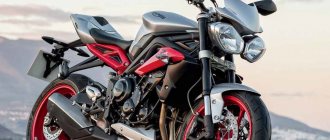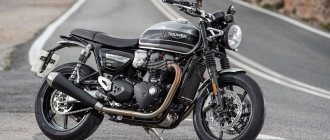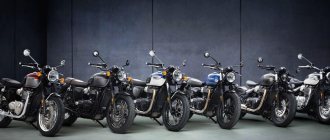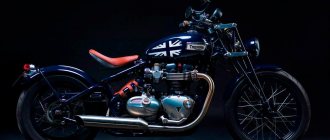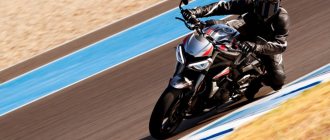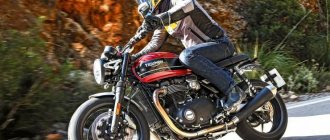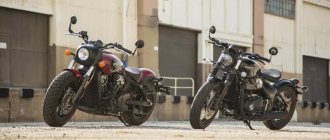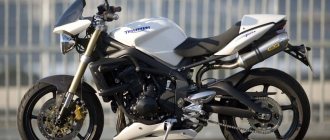“Hitting the right spot” is one of the few clichés that I actually like. This is that special moment when you know that there is a Lord in heaven and everything went right - not just good or bad, but absolutely right.
Triumph Street Twin Motorcycle This expression comes from tennis and describes the moment when the racket, hitting the ball, hits the perfect spot and the player directs his blow exactly where he wants to send it. You may not agree with the way the ball was served or the way it went over the net, but because you hit the right spot, you will step back and watch in delight, admitting to yourself that it was done flawlessly.
Triumph has hit a similarly unique spot in the motorcycle space that is irrevocably ideal for its market position. As a superbike rider, you might think the Street Twin is overpowered, but you'd be wrong.
If you're a fan of custom cruisers, you'll probably say it's a bit vague. Of course, it is not a purely classic bike. Proof of this is that the test bike wasn't broken and there wasn't a puddle of oil under the bike when I stopped for lunch!
The 2016 Triumph Street Twin is a very nimble bike that can handle some pretty spirited maneuvers. Firstly, it is worth noting that it is a true classic motorcycle, but one that has absorbed all the advantages of 21st century engineering.
It's also designed in a "Retro" style, in the style of those guys you see in commercials who have forgotten what it's like to shave and seem to be staring into the distance for a long time, trying to find their man bag, left on a designer park bench while they're out. how they drank skim milk lattes with their supermodel girlfriend. It's also going to be the bike that will be used in a ton of custom bikes over the next 12 months because it just screams that it wants to be customized.
So what exactly is the Triumph Street Twin and why is it so important to Triumph?
Firstly, the Street Twin is the biggest Triumph project ever developed and must cost a lot of money. In addition, a tremendous amount of engineering time and effort has been spent on this motorcycle and this is very important for the size of the Triumph company. The Bonneville line was in development for 4 years and took up the entire working time of 50 engineers exclusively on the design team. Add to that the technologists and staff who develop the bike's 150 accessories, and it quickly becomes apparent that this is a bike that Triumph wanted to get right - not just very good, but really right.
The volume of this toy is 900 cm³
The Triumph Street Twin is the first motorcycle in the new Bonneville family.
Triumph Street Twin is the first motorcycle that will combine all the features of the updated, even more likely new, Bonneville family. It's the smallest displacement bike in the 5-bike range, but don't think of the Street Twin as an entry-level machine, a baby Bonneville for those who can't 'do the real thing'. He is absolutely not like that!
One of the challenges for the Triumph Street Twin project is that the old T100, which sold 141,000 units, was an enormous success for Triumph. I've never seen such fan following as the T100 before.
Thus, the primary goal was twofold and complex. The new motorcycle's challenge was to retain existing Bonneville owners as possible customers, while providing them with plenty of reasons why they should want to purchase the latest offering.
The other problem is almost paradoxical. The name "Bonneville" actually takes us back to 1958 and Mike Hailwood and Dan Shorey's victory at the Thruxton 500 in June 1958. Along the way, it was the Bonneville that made the first lap of the TT at 160 km/h as a legitimate production road bike and became Steve McQueen's favorite bike. You simply can't remember Bonneville without a ton of history.
All this means that there was a lot of pressure on the design team to make a real motorcycle, not just a plastic imitation of the great-grandson of the original Bonnie, but the real thing. Undoubtedly, the motorcycle must have a Parallel Twin engine. You probably don't have a 4 cylinder Bonnie, otherwise old men like me would go to Hinckley and burn down the factory. Lonely also understands that a motorcycle engine must be compliant, and its exhaust must meet current and projected emissions standards. And Triumph has solved all these problems admirably.
First of all, the new engine looks absolutely great. Sure, it's no 1958 Bonnie, but any smug grandpa would look at its wide-spanning, ribbed exhaust ports and cute, angular engine lines with a sense of pride. He would start saying in a cooing voice: “Oh yes, this is my favorite little friend and he looks just like his grandfather, right?”, which of course is absolutely true, because... he really looks like 1958 Bonnie.
However, underneath the Triumph Street Twin's family-friendly looks lies a very modern engine. The key factor is that the engine is partially water cooled. This is very important because... the motor has become more reliable and responsive to adjustments. But it is also air-cooled, and its radiator is small and modest.
Stainless steel exhaust pipes
The working volume of this toy is 900 cm³. This Triumph bike features a single overhead camshaft with a unique eccentric cam shape to open 8 valves. As a final result, the company received only 55 hp. The maximum power from your new bike is at 5900 rpm, but don't let that fool you. Its engine has very good torque, which is 80 Nm at 3230 rpm, i.e. When driving, it will provide you with plenty of practical, usable power.
The motorcycle engine structure is SOHC type. Dry weight is almost 198 kg, but it feels lighter than it actually is. Mass centralization is as important for a retro bike as it is for a MotoGP machine, and as for this bike, it actually feels very controlled.
What is so “smart” about a motorcycle that is hidden from our eyes? Let's take a catalyst for example. If you are a journalist who walks around a motorcycle and, out of curiosity, tries to find where the catalyst is, you will never find it, because... it is very well hidden under the engine.
However, you will see the beautiful dual stainless steel exhaust pipes. They look and sound, creating a throaty rumble, simply great. Also, the motorcycle exhaust is completely legal and has been tested for noise levels when accelerating the motorcycle. When riding, the bike produces a beautiful sound similar to tenor music.
Triumph proudly presented its Vance & Hines scrambler exhaust as an optional (non-standard) kit to the international press and we all had to stand in awe. Okay, but I'm a little unsure. Instead of the authentic and glorious classic "growl" of the standard Street Twin exhaust, the company is offering a deafening, to say the least, cacophonous exhaust that I am 101% sure will irritate and alienate the public.
Installing exhaust systems like this on a road bike is a pointless exercise, designed only for those who look at themselves in the mirror in the morning and think:
Is this all I have to offer this world? I can't ride with half the skill at a decent level, oh well, then I'll make the loudest noise possible, even for the least valid reason.
Why Triumph officially supports alienating the non-motorcycle population is a mystery to me.
It's 2015 and bikes need to have good fuel injection and Triumph has done an excellent job of delivering a superb fuel injection system that works great from idle to rev limiter. at 7000 rpm. The bore and stroke of 84.6 x 80 mm are perfect for this motorcycle's engine. Triumph has spent a huge amount of time developing an engine cam profile that is worth all the effort and money spent.
The ignition angle of the motorcycle is 270°. All this, in principle, is the result of ordinary modern engineering.
2022 updates
Are the 2022 Triumph Street Twin and Street Scrambler an update, a new generation or a redesign? Well, if a bike's engine body looks the same as last year's and the frame is mostly the same, then it's not "new." Triumph has never talked about “new things” or “a complete redesign” in its press releases, but the “new generation” they talk about is pretty much okay.
The letters HT on the side of the 2022 engine crankcase cover mean High Torque - that is, high torque. This abbreviation is located right next to the inscription “900”, indicating the cubic capacity of the engine. For the 2022 model, the 900HT gains 10 horses and 500 rpm more (7,500 rpm is the new top speed). The increase in power is one of the significant updates to the Street Twin and Street Scrambler. Adding 10 horses while maintaining the same cubic capacity and design is not so easy, is it? There were rumors of a new camshaft profile, high compression pistons, and of course an increase in throttle size.
Not at all! We simply reduced the mass of the crankshaft, balancers and parasitic shafts
A Triumph spokesman said proudly. Developing and testing the new elements took some time, plus they did a little magic with the fuel map - and - welcome, lady's gentleman, 10 horses on top.
Is it worth it? This is where opinions are divided. The mild nature of these models made them considered entry-level bikes, and now some owners of previous versions are claiming that the 2022 models have crossed the line into an entry-level motorcycle. They're probably jealous.
Triumph Street Scrambler 2019
The Street Twin motorcycle is very obedient
But from this point on the plot gets really interesting. Triumph has done much more than just give the bike a good engine sound. The engine vibrates, but only from ignition pulses. You can actually feel some shocks, but they are hardly noticeable. They will be a joy for those who truly believe in the 2-wheeled horse and want to feel its heartbeat. Personally, I love to feel the engine talking to me.
For real situations that can be encountered on the road, the engine power of a motorcycle, taking into account its intended purpose, will be ideal. Plus, every twist of the Triumph Street Twin's throttle delivers a big burst of power output. The clutch is also nice and easy to squeeze, and the gearbox is precise and has 5 gears with an ideal ratio. In fact, everything about the bike is so rider-friendly that it's perfect for teaching newbies how to ride a motorcycle.
Like the powertrain, the chassis is much more capable than it might seem at first glance. It is made of steel, has a structure with two shock absorbers, but an important distinguishing feature is that pipes are installed in front and behind the engine for strengthening. It gives a solid, modern feel, which is good for positioning itself in yet another sector of the market that Triumph is trying to attack - sportbike riders are tired of struggling with 175bhp. and the constant threat that their rights could be taken away.
The front forks on the Triumph Street Twin are excellent , however, if I were to purchase a Street Twin, the first change I would make would be to install different quality shock absorbers, sold as aftermarket parts, because the stock Kayaba shock absorbers are good, but nothing more.
The front brake may seem incredibly modest and features a single 310mm disc, Nissin 2-piston floating caliper and ABS. But despite what it looks like on paper, it's a very good brake and you'll never need more stopping power than what it has, even when the Street Twin is fully loaded. The rear brake works in some way and apparently for legal reasons, but I don't think it has much more than decorative value.
The ergonomics of the Triumph Street Twin are excellent - completely first class. The seat height is low, even intimidating, but the thin seat of the bike turned out to be very comfortable, which, in general, was unexpected. One of my friends agreed to help me test the bike and this is very important, since for Triumph this is another market sector that the company is concerned about satisfying. Her height is 165 cm. Sitting on a motorcycle, she was able to put both feet on the ground without any problems. I'm 13cm taller than her and when I got on the bike with her there was still plenty of room for me, plus extra room to stretch out back. Anyone with a height of up to 182 cm will feel very comfortable on the motorcycle. Overall, this is a seriously sensitive piece of design that demonstrates Triumph's care for this project.
The Street Twin motorcycle is very obedient. It is very responsive to driver adjustments. The bike reminds me of my collie bitch waiting at the back door when we get ready to go for a walk. All that's missing is a wagging tail. The motorcycle is equipped with a simulated analog speedometer - in fact, it is electronic and displays information about average and current fuel consumption, as well as mileage. However, this is not a bike that just needs to be played with the electronic options. Street Twin needs to be felt, and not just controlled like a PlayStation joystick.
Between 3000 and 6000 rpm
In reality you should, definitely should, keep it between 3000 and 6000 rpm. Below 2500 rpm, the engine will ask you to add a little more speed for comfort, and if you give it too much gas, it becomes grumpy and irritable. The Street Twin reaches almost 80 km/h in 1st gear, so it cannot be considered a lazy person with sore joints, but it is worth noting that the bike’s engine does not like such speeds.
Also, one of my friends who tested the Triumph Street Twin told me that he accelerated to 177 km/h on it, but neither he nor his motorcycle liked that speed. When I drove it at 130 km/h on a 4-lane highway, the world seemed beautiful to me. No effort, wonderful and graceful - a true gentleman's transport. The Street Twin gets ridiculously little fuel mileage. When riding in a non-economy mode, which is exactly how I drove during my morning test of the bike, fuel efficiency was 23.4 km/l. In the afternoon the computer kept showing 29.7 km/l.
I was lucky enough to ride this motorcycle in the mountains. I can say with absolute honesty that if you want to ride the Street Twin like Malcolm Uphill rode the Bonneville that won the TT in 1969, the bike is completely ready for that, as I have already tested.
I rode in second gear, using the engine as a brake to stop the rear wheel, and had a great time. But on the way back, driving in a more relaxed manner became even more fun for me. The Street Twin, with its big Twin engine sputtering around 3500 rpm (as indicated by the tachometer) in 3rd and 4th gears, proved itself to be a beautiful bike and reminded me why I am a motorcyclist and will remain one until my dying day.
On the dyno
The performance graph really shows that the character of motorcycles has changed, and it's not just about 10 horses. The horses at the beginning of the throttle stroke look exactly the same as on the 2022 version, and it’s unlikely that anyone would tell them apart until the 270-degree inline-two spins over 3,500 rpm. And here the 900 cc unit produces a completely smooth power arc, ending with 65 horses right at the cutoff line. For comparison, the first generation Street twin and Street Scrambler produced a power level of 55 horses at 5700 and dropped to 50 horses at 7000 rpm. This is in numbers, but what about in your fingers?
The old engine, which when cranked up at highway speed began to deflate at the end of the throttle stroke, is a thing of the past. Long live the new, convenient and reliable motor! Its friendliness is complemented by electronic gas, which, with the help of the ECU, further smoothes the response to right-hand actions, turning every millimeter of handle travel into an increase in traction. At the same time, it cannot be said that the gas here is braking or somehow incorrect, but its ergonomics differs from all these “kicks and explosions” on old equipment. If you twist, you accelerate, this makes control easier and safer.
Is it possible to get into trouble with the new 900s? Of course, but no more than in previous versions. The extra power and smoother engine torque distribution make the Street Bonneville line more comfortable for riders of all abilities. And the “Rain” and “Road” riding modes, which exist on both devices, make the bikes even friendlier. These modes affect the character of the engine, as well as the operation of ABS and traction control. The “Rain” mode does not reduce maximum power, but only smoothes the engine response to gas and increases the sensitivity of active safety systems for earlier intervention when driving on slippery surfaces.
Street Scrambler additionally has an “off-road” mode. This mode also does not dumb down the engine or cut power; instead, it disables traction control and ABS, not only on the rear wheel, but also on the front. The ability to completely disable ABS has become a rare and pleasant feature on motorcycles in recent years, because on most front ABS cannot be disabled. Oldfags with retrogrades will say
Well, great, I don’t need these newfangled tricks of yours.
Not a question, but I wonder if Triumph followed their lead or just didn’t want to write an algorithm for ABS to work only on the front wheel?
Triumph Street Twin 2019
By the way, about oldfags. The instrument panel here consists of a single needle speedometer with a small LCD display, but it nevertheless has a settings menu through which you can disable the traction control, but only when the bike is stationary. On top of that, the traction control turns back on every time after turning on the ignition, and this is annoying. While driving, the LCD display can display an odometer, two tripmeters, a power reserve, and also a kind of tachometer. This tachometer here works with a slight delay, so this function rather shows “average engine speed”. Many will ask, why doesn’t it have a real tachometer? Well, probably because the smooth nature of the engine allows you to do without it for the sake of a laconic design.
Are Street Twin and Street Scrambler the same model or two different ones? Perhaps they differ only in body kit and wheels? Nothing like this. They feel radically different, and it all starts with the steering wheel.
Features of the 2016 Triumph Street Twin
Engine: Parallel Twin 900cc 8-valve SOHC 270° Bore x Stroke: 84.6 x 80mm Compression Ratio: 10.55:1 Maximum Power: 55 HP at 5900 rpm Maximum torque: 79.99 Nm at 3230 Fuel delivery: Multiport sequential fuel injection Exhaust: 2-into-1 exhaust system with dual mufflers Final drive: O-chain Clutch: Wet multi-disc with assist Transmission: 5- stepped Frame: Tubular steel Swingarm: Double-sided, tubular steel Front suspension: 41mm Kayaba fork, 101.6mm travel Rear suspension: Twin Kayaba shocks with preload adjustment, 101.6mm travel Front Wheel: Cast aluminum alloy, 457 multi-spoke .2 x 50.8 mm Rear wheel: Cast aluminum alloy, multi-spoke 431.8 x 101.6 mm Front tire: 100/90-18 Rear tire: 150/70 R17 Front brake: 310 mm disc, 2-piston floating caliper Nissin, ABS Rear Brake: 255mm disc, Nissin 2-piston floating caliper, ABS Seat Height: 736.6mm Wheelbase: 1422.4mm Rake/Trail: 25.1° / 101.6mm Dry Weight: 198.2kg (claimed) Fuel tank volume: 11 l Exhaust emissions: Euro 4 compliant Standard equipment: ABS, traction control, Ride-by-Wire electronic throttle control, immobilizer, USB port, LED taillight Color options: Jet Black, Phantom Black, Matte Black, Aluminum Silver, Cranberry Red
